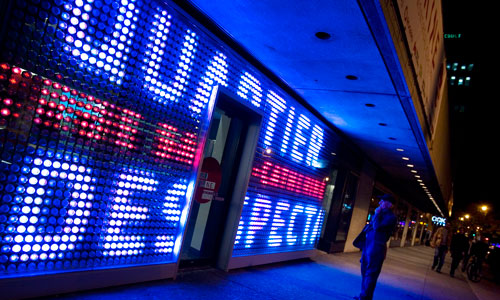The Quartier des Spectacles: Giving Montreal a New Life by Hassan Laghcha
/ October 1, 2014
Version française...

It’s been more than ten years since the idea of the Quartier des Spectacles (the “entertainment district”) appeared among Montreal’s cultural elite. Its supporters asserted that the project was necessary to reposition Montreal as a cultural metropolis of international calibre, and its feasibility was confirmed at the Montreal Summit of 2002. Since then, almost $150 million has been invested to give Montreal a facelift. Here is an overview of the highlights and an outlook on the evolution of this, the heart of culture and the arts in Quebec.
In 2001, representatives from the cultural milieu, united by ADISQ (Association québécoise de l’industrie du disque, du spectacle, et de la vidéo) met with the goal of launching the Quartier des Spectacles (QdS) project in order to galvanize Montreal’s cultural scene. One year later, the City of Montreal made the QdS a priority in order to strengthen the bigger festivals and enhance the city’s cultural institutions and performance halls. In 2003, the Partenariat du Quartier des Spectacles was created and became responsible for the events and programming in the district. This organization, composed of six sectorial and thematic committees and equipped with a board of directors, brings together some sixty members representing business and cultural interests together with local and provincial administrations.
Toward 2017
In November 2007, the QdS project was written into Montreal’s 2007-2017 Action Plan: Montreal, Cultural Metropolis. The City of Montreal and the provincial and federal governments pledged a total of $120 million to finance construction in the Place des Arts sector and the creation of new public spaces (including the Place des Festivals, the Parterre, and the Promenade des Artistes) as well as numerous building projects, including several cultural spaces, namely Montreal’s Maison symphonique and the 2-22 building that houses the Vitrine Culturelle, CIBL radio, the VOX artist centre, the Artexte Information Centre, and the Regroupement des Centres d’Artistes Autogérés du Québec (the Association of Self-Managed Artists’ Centres of Quebec), among others.
A Little History
The Quartier des Spectacles is largely situated in Montreal’s former red light district, which dates back to the beginning of the 1800s and also houses many emblematic buildings including the Gesù Theatre (constructed as a chapel and academic hall in 1865), the Monument-National Theatre (1893), the Théâtre Gayety (1912, now the Théâtre du Nouveau Monde), and the Théâtre Saint-Denis (1916). Starting in the 1920s, cabarets abounded and attracted internationally renowned artists. Montreal’s reputation as a party town was made, helped by the Prohibition laws south of the border (1920 to 1933).
Remarkable Facts
In 1982, the Festival International de Jazz de Montréal presented outdoor shows in the Quartier des Spectacles for the first time. The public enthusiasm thus created largely contributed to the financial security of the festival, which draws 50% of its budget from private sponsors. In 2009, the Maison du Festival de Jazz was created in the Blumenthal building, including a concert hall (L’Astral, seating 320), the Balmoral restaurant and the Galerie Lounge TD art gallery. The same year, the Partenariat du Quartier des Spectacles addressed a letter to the Société de Transport de Montréal asking that the Saint-Laurent Metro Station, situated in the heart of the QdS, be officially renamed “Saint-Laurent – Quartier des Spectacles”. The goal was to give visitors and tourists a reference point to better mark the cultural destination, a one-kilometre-square quadrilateral spread out around the intersection of Sainte-Catherine and Saint-Laurent and demarcated by City Councillors, Berri, and Sherbrooke streets and René-Lévesque Boulevard.
In September 2009, the Place des Festivals was the first QdS project to be completed. With an area of 6141m2, it includes four huge lighting structures, two restaurants, and an interactive fountain.
In May 2010, the Parterre was created at the corner of Saint-Urbain Street and De Maisonneuve Boulevard. This new public space contains an area of 3455m2, mostly grass, and welcomes numerous festivals and events including the Festival Nuits d’Afrique. In September 2011, the Maison symphonique, a concert hall that seats 2100 and houses the Orchestre Symphonique de Montréal and the Orchestre Métropolitain as well as ensembles such as the Violons du Roy and the McGill Chamber Orchestra, was inaugurated.
Some Key Numbers
• The QdS hosts over 40 events each year, attracting over 5,000,000 festivalgoers. It includes 6 public spaces with an area of 27,300m2.
• The district is the 2nd most popular cultural destination in Greater Montreal, behind Old Montreal.
• Currently, the QdS concert halls welcome around 1,700,000 spectators, representing 25% of total indoor concert attendance in Quebec and 26% of total ticket revenues in the province.
• In the last 5 years, the number of residents in the district has risen by 30%. This is due to multiple new residential building projects downtown.
The Serious Problem of Suburban Competition
Performance attendance and ticket revenues in Quebec are showing the biggest drop in ten years. According to the most recent figures from the Institut de la Statistique du Québec, this drop is even more marked for Montreal performance venues, where attendance has dropped to 3.1 million audience members, the lowest level in ten years.
This alarming decline can be explained by the growing appeal of suburban performance venues. Venues on Montreal’s periphery have seen their attendance grow from 14% in 2007 to 20% in 2013.
The biggest decline was seen by circus and magic performances (- 43%) and musical theatre and music hall performances (- 43%).
Translation: Rebecca Anne Clark
Version française... | |

